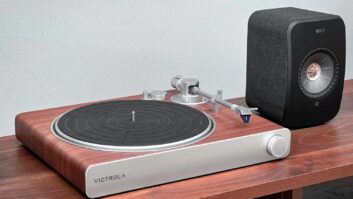Swampscott, Mass. – Start-up ZVOX Audio has begun marketing a set-top TV-sound system that amplifies, widens and deepens the sound stage at $199.
The company, whose mission is to “de-complicate home audio,” is targeting its first product primarily to owners of full-fledged home theater systems who want improved TV sound in bedrooms, kitchens, and other small rooms without adding large boxes or wiring up six speakers. The ZVOX 315 Sound is also touted as a way to enhance the sound of game systems and PCs. It can also be used to deliver quality sound from an unamplified satellite-radio tuner or HDD headphone portable.
The 315 is the first of a trio of systems designed primarily by ZVOX as TV-sound enhancements. At least one other company is in this market: Soundmatters of San Francisco.
ZVOX, founded by Cambridge SoundWorks alumnus Tom Hannaher, has begun marketing the 315 on its web site (www.zvoxaudio.com) and has won commitments from select retailers to test -market the products.
The 315 is DVD-player size at 4.25 by 17 by 15 inches. A second product under development will be wider and less deep, enabling it to sit on top of a wider selection of TV sets. The dimensions will be 4 by 27 by 6.5 inches. For wall-hanging plasma TVs, Hannaher plans a model that will mount on the wall above a wall-hanging plasma TV.
Hannaher claimed the 315 is the only product of its kind with the following four attributes: small size, affordability, hook-up and operational simplicity, and ability to fill a “good-size” room with sound.
The device turns on automatically when its senses TV-audio on the minijack cable. No remote is needed to operate the device. For hook-up, consumers plug one of the 315’s two stereo mini inputs into the TV.
The 315’s MDF cabinet features threeforward-firing full-range drivers, a 5.25-inch vented woofer, and 40-watt digital amplifier. The system feeds mixed left- and right-channel information to the center driver. To widen the sound stage, the right driver gets right-channel information plus out-of-phase left-channel information, while the left driver gets left-channel information and out-of-phase right-channel information.
For more information, see www.TWICE.com.













